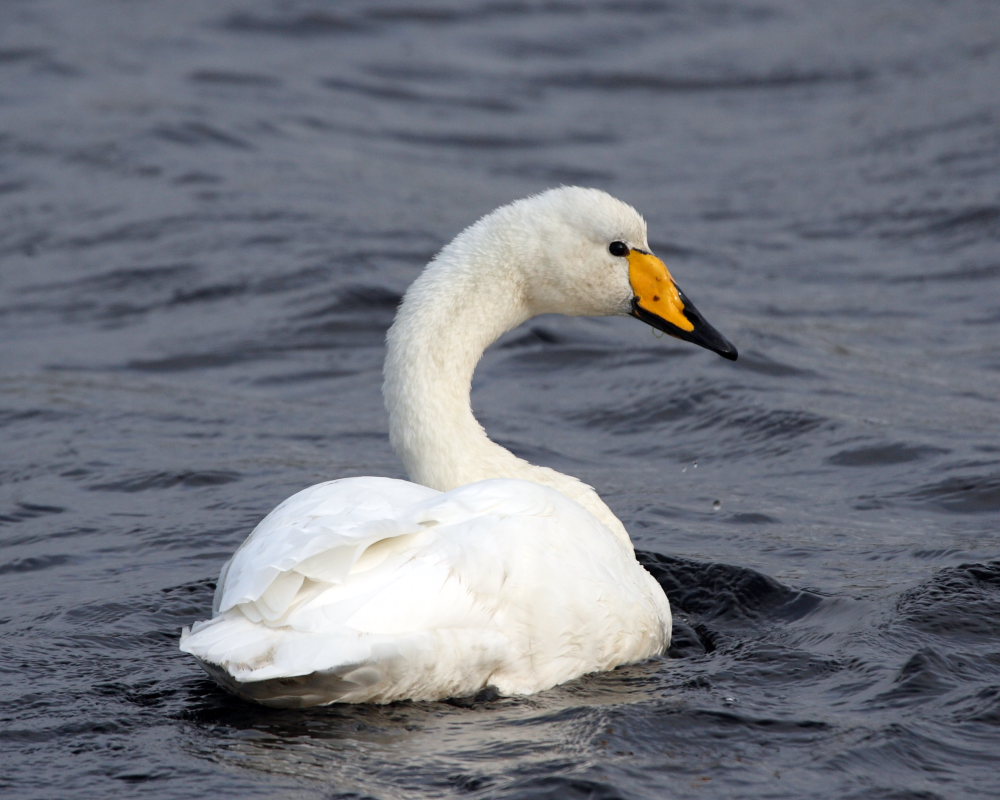Blagdon Lake Birds
Whooper Swan Cygnus cygnus [Linnaeus, 1758]
(Very rare PM & WV)

- One, adult, 9th Feb. to 8th April 1956 (B. King, A.C. Leach et al.).
- Two, not aged, 20th-27th Dec. 1961 (M.W. Seaford & T.B. Silcocks).
- Twelve, not aged, 14th Jan. 1962 (B.K. Brooke).
- Four, not aged, 3rd Nov. 1962, twenty on 4th , eighteen on 11th, & eleven on 18th (R.M. Curber, G. Sweet, J.W. Watkin & C. Lachlan).
- Four, not aged, 7th Feb. 1965 (A.H. Davis, K.L. Fox, R.J. Senior & K.E. Vinicombe).
- Eight, 5 adults & 3 juveniles, 7th Dec. 1974 (J.T. Lovell).
- One, adult, 23rd Dec. 2011 (N.R. Milbourne).
- Three, adults, 18th Nov. 2012 (N.R. Milbourne, P.& L. Delve, T. Doman).
- One, adult, 5th Dec. 2017 (N.R. Milbourne et al.).
- One, adult, 4th Nov. 2021 (P. Williams et al.).
The Whooper Swan Cygnus cygnus breeds across the Palearctic from Iceland (the Greenland population is now extinct) to the east coast of Russia with four population centres being suggested; Icelandic, North-west European, Central and East Russian. Whoopers tend to breed south of the open tundra zone, favoured by Bewick's Swans, into the taiga forest. Most of the Whoopers that visit Britain and Ireland fly in from Iceland, though a proportion remain there depending on weather and food availability. There are a number of records of birds from the North-west European population occurring along the east coast, but they generally remain in continental Europe unless the weather drives them over. There has been an instance of an Icelandic-ringed individual changing from one population to another and breeding in Finland, but it is thought that the rate of interchange is low. There has been an increase in the Icelandic population between the 1960s and mid-1980s (the 1st International census in January 1986 counted 16,700), and a coordinated census in January 2000 found a total of 20,856 birds, with a distribution of 30-33% in Great Britain, 61-66% in Ireland and the remainder in Iceland (Kear, 2005).
Whooper Swan records at Blagdon Lake are few and concentrated between 1956 and 1965. The record of 12 birds dated 14th January 1962 is best considered unsafe at present, due to the possibility of mistaken identity, unless more evidence comes to light.
There have been two additional records. One was claimed, in 1974, but more proof is required before counting it in the total. John Aldridge did some investigation for me and found the following information about this record: The observer was Julian T. Lovell on 7th December 1974. The notes say "15.40 hrs. 8 birds, 5 ad & 3 juv. arriving lake from S. moved across lake. 16.15 hrs. 2 imm & 1 ad. in company with above. Cl. 8/8, wind 4 S.W. Temp 8 degrees C, Dry." He must have been asked for more information by Paul Chadwick as there is a letter with supporting information. Julian stated that he had not considered Jankowski's Swan as an alternative. Jankowski's Swan that Julian referred to is the larger, East Siberian population of Bewick's Swan Cygnus columbianus. I'm puzzled as to whether there were actually eleven birds after reading the above and feel that the likelihood of birds from the eastern Eurasian population flying over Blagdon to be barely worthy of consideration, so that seems to be a strange comment to have made.
A single Whooper Swan was found at Chew Valley Lake on 23rd December 2011 and was later seen to fly towards Blagdon by Richard Mielcarek, who rang to tip me off. I arrived some 45 minutes later and was just in time to see it fly low overhead and off south-west over Blagdon village with four Bewick's Swans, having left two of the original flock of six Bewick's Swans at Top End.
Another recent record was of three adults that were found in front of the Fishing Lodge by the author while carrying out a WeBS count. They swam out into the middle of the dam end, took off and flew away to the west.

There seem to be more instances of Whooper Swan at nearby Chew Valley Lake and the Somerset Levels in recent winters so, perhaps, we might expect to get more records in coming years, unless climate change results in fewer birds leaving Iceland to winter this far south.
Bibliography (sources of information):
- Davis, H.H. (ed.). Bristol Bird Report, 1956. Bristol Naturalists' Society.
- Davis, H.H. (ed.). Bristol Bird Report, 1962. Bristol Naturalists' Society.
- Davis, H.H. (ed.). Bristol Bird Report, 1965. Bristol Naturalists' Society.
- Davis, H.H. (ed.). Report on Somerset Birds, 1956. Somersetshire Archaeol. & Nat. Hist. Soc.
- Davis, H.H. (ed.). Somerset Birds, 1962. Somersetshire Archaeol. & Nat. Hist. Soc.
- Davis, H.H. (ed.). Somerset Birds, 1965. Somersetshire Archaeol. & Nat. Hist. Soc.
- Rose, Dr H.E. (ed.). Avon Bird Report, 2011. Avon Ornithological Group.
- Savory, J.H. (ed.). Somerset Birds, 1961. Somersetshire Archaeol. & Nat. Hist. Soc.
- Taylor, S.M. (ed.). Avon Bird Report, 1983. Avon Ornithological Group.